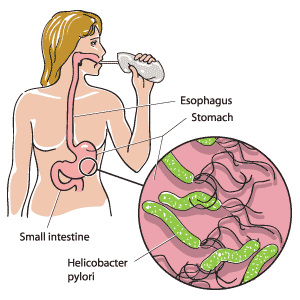
The
above-captioned review article caught my attention. It is by Goderska et al. Appl Microbiol
Biotechnol (2018) 102:1–7.
Helicobacter pylori (H. pylori) is a motile, curved and Gram negative bacillus. H. pylori certainly is the most prevalent human infection. The frequency of infection due to H. pylori is nearly 50% in the world and in developing country is as high as 80%-90%. This bacterium colonizes the stomach of human and its infection is correlated with gastritis, peptic ulcer disease and extra-digestive diseases.
H. pylori is also considered as a human carcinogen. H. pylori are also involved in the development of other extra-gastric disorders such as mucosa-associated lymphoid tissue lymphoma (MALT), idiopathic thrombocytopenic purpura, vitamin B12 deficiency, and iron deficiency. Eradication of H. pylori could help in the management of these H. pylori-associated disorders.
Unfortunately, therapy against H. pylori has turned out to be more difficult over the years, principally due to the great decrease in efficacy of standard eradication therapies.
Failure of treatment in H. pylori infections has become a topical issue for health care providers. The cause of treatment failure could be grouped into microorganism-related factors, host-related factors and treatment-related factors. H. pylori resistance to antibiotic is widely recognized as the chief reason for treatment failure.
For the last two decades, the standard triple therapy was the gold standardin the treatment of H. pylori infections. The standard triple therapies are based on a proton pump inhibitor,clarithromycin, and amoxicillin or metronidazole. The increasein the prevalence of resistance to these antibiotics, especiallyto the key antibiotic, clarithromycin, has decreasedthe efficacy of standard regimens.
In a recent systematic review, the global incidence of primaryH. pylori resistance to clarithromycin has been reportedto be as high as 17.2%. The prevalence of H. pylori resistance toclarithromycin varies among different countries, such as10.6 to 25% in North America, 16% in Japan, and 1.7 to23.4% in Europe. This disparity in resistance rates seemsto be correlated to the national level of macrolide consumptionand different policies for antibiotic consumption in differentcountries. The increased use of macrolides in the treatment respiratory tract infections could contribute to resistance to H. pylori.
Metronidazole is a key component included in the tripletherapies which is associated to ahigh level of resistance. The prevalence of metronidazole resistancehas been estimated to be from 17 to 44% for Europeand America, respectively.
The percentage of metronidazoleresistance in developing countries has been reported from 50to 100%, and up to 90% in Africa. The resistance to metronidazole is so high in developingcountries because this antibiotic is widely used to treatparasitic and/or gynaecological infections in female patients.
As a result of these developments, standard triple therapies maynot be recommended anymore for empiric use. Due to the highlevel of resistance to the two key antibiotics of standard tripletherapies, clarithromycin and metronidazole, and the differentpatterns of resistance in different populations, standard tripletherapies should be adapted to the local resistance pattern, andwhen possible, treatment should be based on susceptibilitydata obtained by testing the strain after culture.
Alternative strategies are being implemented in clinicalpractice to treat H. pylori-resistant strains. This include developmentand use of novel and more effective treatments anduse of probiotics to improve the eradication regimens anddecrease the antibiotic side effects
The Bismuth quadruple therapy contains two antibiotics, tetracycline and metronidazole,plus bismuth and proton pump inhibitor
(PPI) for 14 days.This therapy is preferred as a first-line treatment option forareas with a high incidence of clarithromycin resistance andalso as second-line therapy when first line treatment with the classicaltriple therapy against H. pylori has failed. This therapy works totally independent ofclarithromycin, the key culprit in terms ofresistance. The potential toxicity of bismuth as well as the non-availabilityof bismuth salts or tetracycline in some countries
is the main impediment related to this therapy.
The Sequential therapyuses the same antibiotics as standard tripletherapy, but given sequentially: 5 days with aPPI (such as esomeprazole, rabeprazole) plus amoxicillin, followed by 5 days of PPI plusclarithromycin and amoxicillin.Amoxicillin is administrated first, due to the fact that amoxicillindisrupts the bacterial cell walls to prevent the developmentof efflux channels transferring the rest of the antibioticsout of bacteria. In a recent meta-analysis, eradication rate was 84.1% for the sequentialtherapy in comparison with 75.1% for the standardtriple therapy. Sequential therapy seems to be more effectiveagainst patients with the single clarithromycin-resistant strain.
The Non-bismuth quadruple therapyis another valid therapy in countries with high incidence toclarithromycin resistance. This therapy contains PPI [but withoutbismuth], clarithromycin, amoxicillin, and metronidazolefor 10 days. The main disadvantage of this treatment is thelarge number of pills in comparison with other therapies.In a meta-analysis comparing non-bismuth quadrupletherapy and the standard triple therapy, the eradication ratewas 90 vs. 78%, respectively. Clarithromycin resistance mayreduce the efficacy of non-bismuth quadruple therapy.
The Hybrid therapyis based on 7 days of therapy with PPI andamoxicillin, followed by 7 days quadruple therapy with aPPI, amoxicillin, clarithromycin, and metronidazole. Thereare not many data in the literature, comparing this therapy withothers (standard or sequential therapies), but the results donot indicate that hybrid therapy will be superior to sequentialtherapy.
The Levofloxacin-based therapies involve the use of the quinolone, Levofloxacin to substitute clarithromycin in triple or sequentialregimens. The eradication rate of therapies containinglevofloxacin could be more than 90%, especially in areaswhere the local resistance to levofloxacin is low [less than10%]. As for clarithromycin and metronidazole, an increaseof levofloxacin resistance is being found, due to the fact thatquinolones are often used for the treatment of urinary infections.
Probiotics are defined as living microorganisms that, whenadministered in adequate amounts, can improve microbial balancein the intestine and exert positive health effects on thehost, including beneficial effects on theprevention of intestinal infections, cardiovascular disease,cancer, and anti-allergic effects.The most used probiotic bacteria are Lactobacillus and Bifidobacterium. Probiotics could improve H. pylori eradication and reduce side effects during therapy. Due to difficulty in treating H. pylori mainly because of acquired resistance tocommonly used antibiotics, there is a growing interest in usingprobiotics in conjunction with antibiotic regimens to eradicateH. pylori.
Probiotics have been proven to be useful in thetreatment of several intestinal diseases such as diarrhoea, inaddition to the benefits of probiotic bacteria in the intestines. Triple therapy regimens containing two antimicrobial agents havebeen the standard therapies against H. pylori infection formore than 15 years. However, the increase in the prevalenceof macrolide resistance, mainly clarithromycin, has decreasedthe efficacy of these therapies to unacceptably low levels inmost parts of the world, resulting in the necessity of studyingother possible therapies in order to eradicate the pathogen.As of now probiotics cannot be recommendedto be used as a single agent for eradication therapy.They could be used as adjuncts to standard treatment to improve the eradiation rates and decrease treatment-relatedside effects.
DR. EDWARD O. AMPORFUL
CHIEF PHARMACIST
COCOA CLINIC




